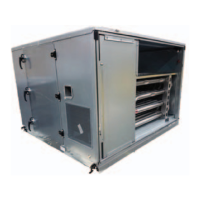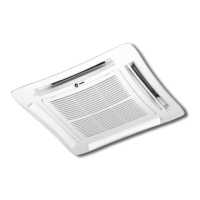Piping and Connections
CLCH-SVX07K-EN 103
To prevent coil damage, complete the following
recommendations:
• Install a 1/2-inch NPT, 15 degree swing check valve
vacuum breaker with cracking pressure of 0.25 inches
Hg (3.4 inches water) or lower at the top of the coil. This
vacuum breaker should be installed as close to the coil
as possible.
• For coil type NS, install the vacuum breaker in the
unused condensate return tapping at the top of the
coil.
• Vent the vacuum breaker line to atmosphere or
connect it into the return main at the discharge side of
the steam trap
Note: Vacuum breaker relief is mandatory when the coil
is controlled by a modulating steam supply or
automatic two position (ON-OFF) steam supply
valve. Vacuum breaker relief is also recommended
when face-and-bypass control is used.
Proper steam trap installation is necessary for satisfactory
coil performance and service life. For steam trap
installation:
1. Install the steam trap discharge 12 inches below the
condensate return connection. Twelve inches provides
sufficient hydrostatic head pressure to overcome trap
losses and ensures complete condensate removal.
a. Use float and thermostatic traps with atmospheric
pressure gravity condensate return, with automatic
controls, or where the possibility of low-pressure
supply steam exists. (Float and thermostatic traps
are recommended because of gravity drain and
continuous discharge operation.)
b. Use bucket traps only when the supply steam is not
modulated and is 25 psig or higher.
Note: Trane steam coils require a minimum of 2 psi of
pressure to assure even heat distribution.
2. Trap each coil separately to prevent holding up
condensate in one or more of the coils.
3. Install strainers as close as possible to the inlet side of
the trap.
4. If installing coils in series airflow, control each coil
bank independently with an automatic steam-control
valve. Size the traps for each coil using the capacity of
the first coil in direction of airflow.
5. Use a modulating valve that has linear flow
characteristics to obtain gradual modulation of the coil
steam supply.
Note: Do not modulate systems with overhead or
pressurized returns unless the condensate is
drained by gravity into a receiver, vented to
atmosphere, and returned to the condensate
pump.
6. Pitch all supply and return steam piping down 1 inch
for every 10 feet in the direction of the steam or
condensate flow.
Figure 133. Typical piping for Type NS steam coils and
horizontal tubes for horizontal airflow
NOTICE
Breaker Cracking Pressure!
Failure to follow these instructions could result in
equipment damage. The 1/2-inch NPT, 15 degree swing
check valve vacuum breaker is recommended because
other vacuum breakers, such as spring-loaded ball-
check breakers, have cracking pressures as high as 1.25
inches Hg (17 inches of water). Vacuum breakers with
fitting sizes smaller than 1/2 inch NPT are too small to
relieve vacuum quick enough to ensure complete
condensate drainage. Other types of swing check valve
vacuum breakers are acceptable if the fittings size is
not smaller than 1/2-inch NPT and the cracking
pressure is not larger than 0.25 inches HG (3.5 inches of
water).
Full size of
coil connection
ST
GV
MV
Steam main
Pitch down
VB
GV
Airflow
12 in. min.
FT
ST
12 in. min.
Full
size
of
main
VB
GV
ST
FT
Return main
Full size of
steam trap
connection
ST
FT
NOTICE
Coil Condensate!
Failure to follow these instructions could result in
equipment damage. Condensate must flow freely from
the coil at all times to prevent coil damage from water
hammer, unequal thermal stresses, freeze-up and/or
corrosion. In all steam coil installations, the condensate
return connections must be at the low point of the coil.
